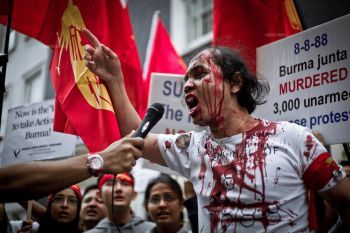
Publisher:
Bonnie King
CONTACT:
Newsroom@Salem-news.com
Advertising:
Adsales@Salem-news.com

~Truth~
~Justice~
~Peace~
TJP
Apr-22-2014 11:45

 TweetFollow @OregonNews
TweetFollow @OregonNews
Channeling Diversity into Democracy: Myanmar's Unfolding Nemesis
Mike Joseph Special to Salem-News.comMyanmar like India could safeguard the interest of minorities by launching government facilitated schemes for their economic and social upgradation.
 Burma Times |
(KUALA LAMPUR Burma Times) - Ethnic strife in Myanmar has brought out a face of Buddhism which was never known to the world. While Buddha set out an example of compassion for others, the exact opposite is being followed in present day Myanmar. Since the last two decades, the talking point for the international community about Myanmar has been the repression of civil liberties, human rights violations and the tribulations under the authoritarian regime which are pushing ethnic issues somewhat out of focus. At a challenging crossroad on its way to democracy, the gravest challenge that the country faces today in the process of nation-building is integrating the ethnic minorities of the country into the mainstream.
The failure to manage Myanmar’s diversity has resulted in ethnic conflicts, some of them started even before independence, hence making it the longest civil war in the world. One such conflict is of the Rohingya community who have been the victims of violence and institutionalized discrimination in Myanmar. Today the country has become a hotpot of ethnic violence, extremism and insurgency. Ethnic groups with a small population and low exposure to development ultimately tend to suffer from an identity crisis because of the constant suppression.
Ethnic identity has both objective and subjective connotations. Objectively it is – primordial affinities and attachments and subjectively it is – an activated primordial consciousness. In the case of Myanmar, Ethnic organizations remain deeply sensitive to the Buddhist population and social exclusion is carried out for every other ethnic minority. The primary grievance of the ethnic minorities is their disenfranchisement from the political process of the country making them absolutely excluded from the mainstream. This in turn results in their social and economical exclusion. In Myanmar, during the military rule, they were also repressed culturally, religiously and socially which further marginalized them. The ethnic minorities now dwell in abject poverty with barely any means of formal employment or identity.
Speaking globally, Myanmar is not the only country which is marked by variation in ethnicity. The country could learn from successes in India in terms of accommodating ethnicity in democracy and turning the nation into a land of equality for each ethnic group. Many ethnic nationalities exist in India and in a broader picture; India not could only help Myanmar to establish a democratic process, but can also help to look at the question of various ethnic nationalities in a national set-up. India presents a fascinating picture of assimilation of multi-ethnic groups in its mainstream at different points of time be it racial, social, occupational, or religious, and still remain stable. The incorporation of minority never disturbed its existing internal social order nor did it ever prevent any new group from join it. It allowed all incoming groups to preserve their own specialties and indigenous culture and still be a part of the larger culture.
Despite enormous pressures, India has been remarkably successful in accommodating cultural diversity and managing ethnic conflict through democratic institutions. Religious harmony, not mere tolerance, is the bedrock of India’s secularism. Enshrined in the Indian Constitution therefore, are several rights that are intended to protect the interests of all citizens, including religious minorities. It is also the solemn duty of the Government to make every possible effort to protect and promote secular values and provide equality of opportunity to all ethnic minorities.
Myanmar like India could safeguard the interest of minorities by launching government facilitated schemes for their economic and social upgradation. The government should incorporate bodies such as the National Commission for Minorities and the State Commissions in India, setting up a regulatory body helps in bringing into focus the responsibility of majority communities to ensure that the rights of minorities are secured. To maintain communal harmony, both majority communities and minorities have to work together to create an atmosphere of acceptance and harmony, which is absent in the case of Myanmar.
This success has been the product of India’s federal system, which has succeeded to keep cultural and ethnic peace. State autonomy and statehood for territorially based regional/linguistic identities remains the most comprehensive method of political recognition of identity in India, and key to India’s plural-cultural federalization.
Myanmar’s ethnic conflict is the world’s longest running conflict and has had an estimated 600,000 casualties so far and there seems to be no quick fix solution to this long-drawn conflict. Myanmar can definitely learn from surrounding Countries on the concept of ethnic incorporation. Reports of some positive developments by the civilian government are surfacing every now and then. With greater involvement of a trusted leader, like Aung San Suu Kyi in the government’s approach towards solving the ethnic issue and President Thein Sein showing signs of reaching a compromise with the ethnic armies through dialogue, the prima-facie situation seems to be improving in Myanmar for good.
Burma Times
http://burmatimes.net/
 |
 |
 |
Articles for April 21, 2014 | Articles for April 22, 2014 | Articles for April 23, 2014
Quick Links
DINING
Willamette UniversityGoudy Commons Cafe
Dine on the Queen
Willamette Queen Sternwheeler
MUST SEE SALEM
Oregon Capitol ToursCapitol History Gateway
Willamette River Ride
Willamette Queen Sternwheeler
Historic Home Tours:
Deepwood Museum
The Bush House
Gaiety Hollow Garden
AUCTIONS - APPRAISALS
Auction Masters & AppraisalsCONSTRUCTION SERVICES
Roofing and ContractingSheridan, Ore.
ONLINE SHOPPING
Special Occasion DressesAdvertise with Salem-News
Contact:AdSales@Salem-News.com

googlec507860f6901db00.html



Terms of Service | Privacy Policy
All comments and messages are approved by people and self promotional links or unacceptable comments are denied.
[Return to Top]
©2025 Salem-News.com. All opinions expressed in this article are those of the author and do not necessarily reflect those of Salem-News.com.